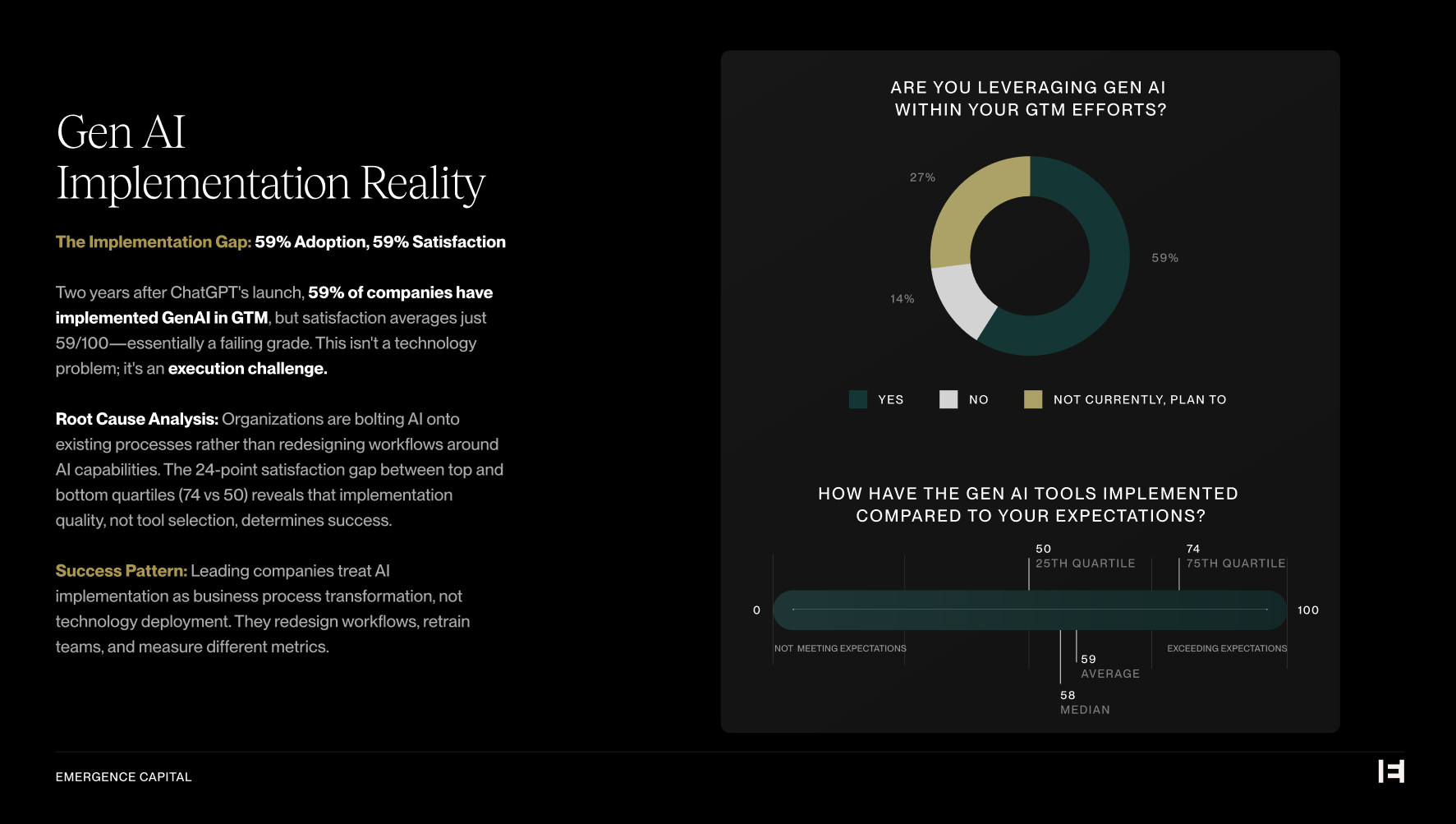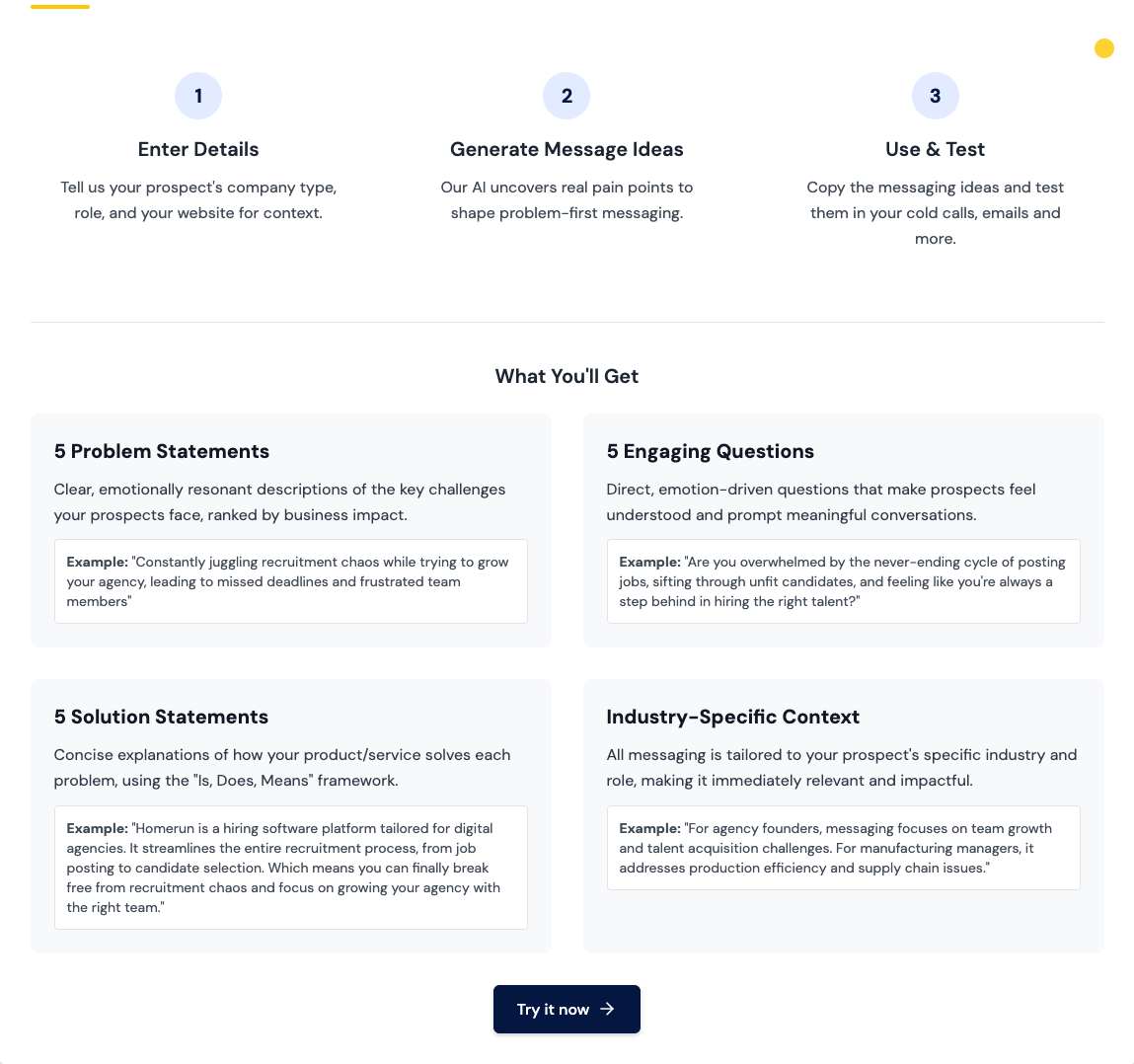Introduction
A recent benchmark report from Emergence Capital shows a striking pattern in how companies are adopting generative AI (GenAI) within their go-to-market (GTM) functions:
- 59% of companies have implemented GenAI in GTM.
- But the average satisfaction score is just 59/100.
Two years after the launch of ChatGPT, AI adoption is nearly universal. Sales teams use it for everything from call summaries (Gong AI), to auto-personalisation features in email platforms (Apollo, Lavender), to content generation for outbound campaigns.
Yet, most leaders would admit they cannot directly tie these tools to meaningful ROI – whether that’s in meetings booked, pipeline created, or deals closed faster.
This is not a failure of technology. It’s a failure of execution and context. Teams are bolting AI onto broken processes, rather than redesigning workflows to make the most of its strengths.

AI Bolted Onto Broken Processes
Emergence’s data points to a 24-point gap in satisfaction between top-quartile and bottom-quartile companies (74 vs. 50). The tools are the same, but the implementation quality is different.
Why?
Poor workflows
Too many reps are copying and pasting prompts into ChatGPT with no system. For example, a rep might type: “Write me a cold email for a VP of Sales.” Without ICP clarity, persona definition, or campaign angle, the output is vague and generic.
Generic use cases
AI is used mostly for “write me a cold email” or “summarise this call.” But it’s not being leveraged for higher-value workflows like multi-threaded account planning, enrichment, or dynamic campaign segmentation.
Lack of training
Sales managers rarely have a framework for AI enablement. Reps are left to experiment, which creates inconsistency and variable quality across teams. One SDR may use AI daily, another may avoid it completely.
Over-reliance
Instead of fixing segmentation, targeting, or list quality, teams let AI generate more volume of the same bad messaging. As one sales leader recently told me: “We’re just sending poor emails faster.”
The problem isn’t adoption – it’s discipline, clarity, and strategy.
Implications for Sales Teams
1. AI doesn’t fix broken inputs
Think of AI like an amplifier. It makes the signal louder, but if your input is noisy, you just get louder noise.
If your ICP isn’t defined, your personas aren’t mapped, and your pain points aren’t understood, AI will only accelerate the mistakes.
Example:
A team with no clear ICP feeds ChatGPT: “Write a cold email for IT leaders.”
The result is a vague, catch-all message. No mention of sector-specific pain points, no alignment with buying triggers, and no reason to reply.
Contrast that with a team who knows their ICP is “Heads of IT at Series B FinTechs scaling to 200 employees.”
When they give that context to AI, the result is sharper messaging about compliance burdens, scaling infrastructure, or SOC2 audit readiness.
The lesson: AI cannot replace strategic clarity. It only scales what you give it.
2. Teams need systems, not just tools
AI on its own is not a strategy. Winning teams build systems around AI usage:
- A prompt library for messaging, with tested structures for different ICPs and personas.
- A campaign builder that combines ICP context with signal triggers (funding round, new hires, technology installs).
- Playbooks that show SDRs exactly how to use AI for enrichment tasks like analysing job postings, reviewing LinkedIn profiles, or scoring leads.
Example:
One SaaS team I worked with built a Notion page with 20+ AI prompts tied to their top personas. Prompts included (changed for confidentiality):
- “Analyse this job posting for pain points relevant to revenue operations.”
- “Draft 3 message angles for a VP of Sales at a 200-person SaaS company that just raised a Series B.”
- “Summarise this earnings call transcript into 3 outbound angles.”
Because reps had these structured prompts at hand, the quality of AI outputs skyrocketed.
3. AI shines in the middle of the funnel
Most teams restrict AI to top-of-funnel tasks like writing cold emails. But the highest ROI comes when AI is applied mid-funnel:
- Multi-threading accounts → Generate variations of messaging for CFOs, RevOps, and Marketing Ops within the same account.
- Personalising nurture sequences → Pull in CRM data (industry, deal stage, previous objections) to create relevant follow-up notes.
- Analysing win/loss data → Extract patterns from closed/lost notes and turn them into actionable targeting improvements.
Example:
A team selling compliance software used AI to review 50+ loss notes. AI flagged that the #1 recurring theme was “integration concerns with [redacted – leading tool in the market].” That insight fed into a new campaign angle, case study, and updated enablement material.
4. Managers must operationalise frameworks
Without structure, reps either misuse AI or underuse it. Sales managers need to:
- Provide battle-tested prompt libraries in Google Sheets or Notion.
- Run enablement sessions to demonstrate when and how AI adds value.
- Track usage and outcomes (e.g. which AI-generated angles led to higher reply rates).
Example:
A VP of Sales introduced a weekly “AI message review.” Reps submitted one AI-assisted email, and the team workshopped improvements live. This created shared learning, accountability, and higher adoption.
They then updated the prompt library to improve the messaging even further.
5. AI enables but doesn’t replace strategy
The teams getting ROI from AI already have strong outbound fundamentals:
- Clear ICPs (that everyone agrees on)
- Defined personas
- Repeatable messaging frameworks
AI is the force multiplier. It helps scale quality outreach faster, but it doesn’t replace human judgment.
In fact, I refuse to talk about AI with clients until the above three are present.
Example:
A rep using Clay + AI might build a list of SaaS companies hiring SDRs, enrich job posts, and then generate messaging about “reducing SDR ramp time.” AI helps them personalise at scale, but the strategic decision to target that segment is what drives the results.
What Good Looks Like: Problem-Led Messaging with AI
(This is a meta example as it is a tool I built to help reps improve their messaging).
One example of AI being used effectively is ProblemMessaging.com, a tool designed to help reps generate outbound message ideas. It’s not valuable because it’s “AI-powered.” It’s valuable because it forces structure.
Here’s how it works…the user must add the following information:
- Company Type → Anchors the message in the right industry and markets and Employee Size Range → Adjusts for the realities of a 30-person startup vs. a 500-person company.
- Persona Definition → Sharpens language to the specific role that you are reaching out to, rather than “decision-maker.”
- Website URL → Ensures the output aligns with what you actually solve by scanning your website and pulling out key messaging.
What it produces:
It takes these inputs, runs it through OpenAI. Within the prompt itself the AI generates:
- 5 Problem Statements – Clear, emotionally resonant descriptions of the key challenges your prospects face, ranked by business impact.
- 5 Engaging Questions – Direct, emotion-driven questions that make prospects feel understood and prompt meaningful conversations.
- 5 Solution Statements – Concise explanations of how your product/service solves each problem, using the “Is, Does, Means” framework.
- Industry-Specific Context – All messaging is tailored to your prospect’s specific industry and role, making it immediately relevant and impactful.

The end result is 5 different message ideas which you can incorporate these problem statements and questions into your emails, cold calls, and LinkedIn messages to engage prospects with relevant pain points.
Allowing you to experiment with various pain points to see which ones resonate more, get more replies, and generate more qualified meetings. Track your results to identify patterns.
It doesn’t spit out a final email. Instead, it gives reps the building blocks to finish the job – avoiding the blank-page problem while still demanding judgment and strategy.
However, the tool falls apart if you aren’t giving it specific company type, specific personas, and if your website isn’t aligned to talking about the problems that you can solve and demonstrate how you’ve solved it. So here you can see that the AI isn’t the problem, but the input often is.
Final Word for Sales Leaders
Generative AI is not underperforming because the technology is flawed. It’s underperforming because sales teams aren’t feeding it the right inputs or building repeatable systems.
To fix this, leaders should start to:
- Build a prompt library tied to ICPs and personas.
- Train reps on how to refine AI outputs into company-specific messaging.
- Encourage tools like ProblemMessaging.com to accelerate structured thinking.
- Create feedback loops (Loom reviews, peer sessions, coaching) to avoid copy-paste culture.
The bottom line: Feed AI with enough context and specificity, and it will deliver tremendous value. Fail to do that, and you’ll simply scale bad habits faster.


